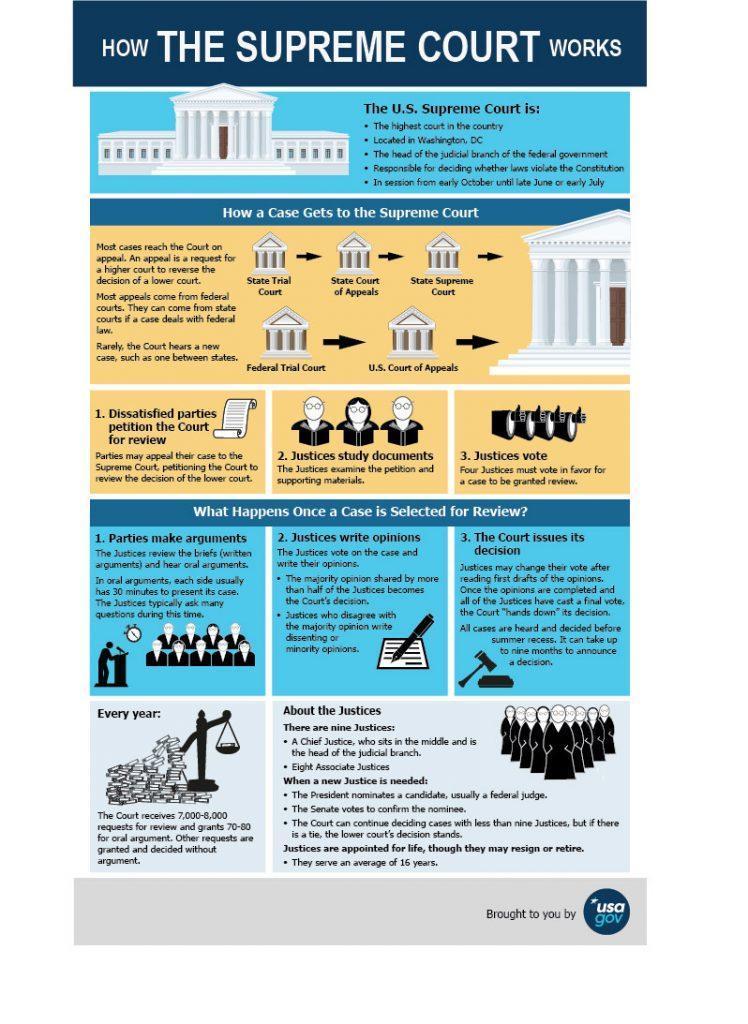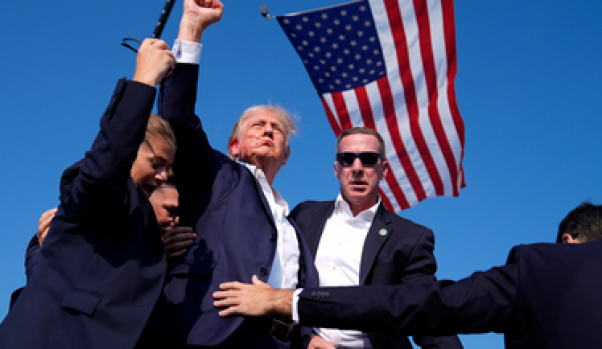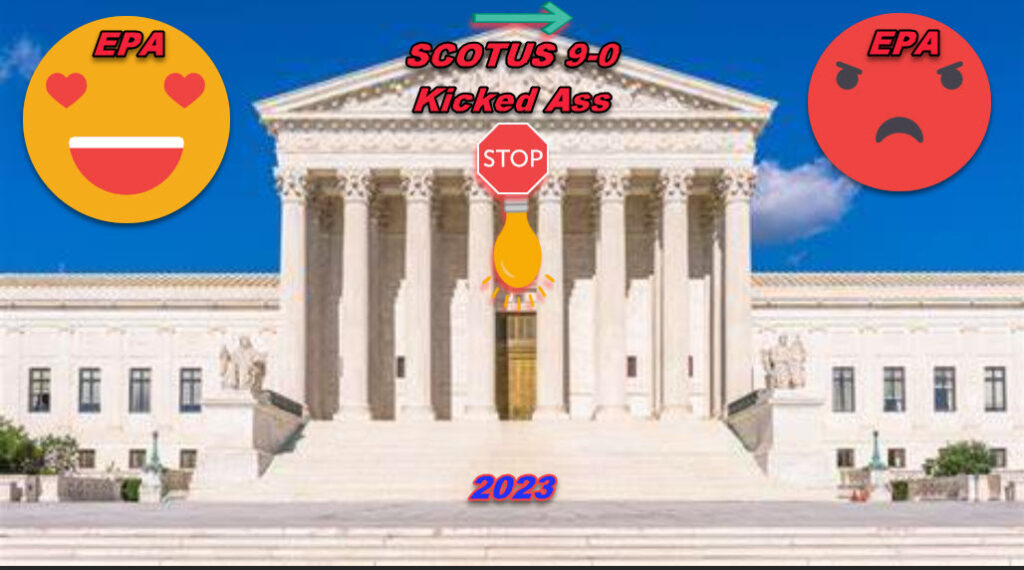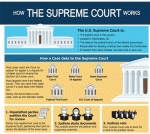How the Supreme Court Works
Link to USA.Gov
About the Judicial Branch
Courts decide arguments about the meaning of laws and how they are applied. They also decide if laws violate the Constitution—this is known as judicial review, and it is how federal courts provide checks and balances on the legislative and executive branches.
Confirmation Process for Judges and Justices
Infographic: How the Supreme Court Works
Judicial Branch
The judicial branch interprets the meaning of laws, applies laws to individual cases, and decides if laws violate the Constitution. It’s comprised of the Supreme Court and other federal courts.
Supreme Court – The Supreme Court is the highest court in the United States. The Justices of the Supreme Court are nominated by the President and must be approved by the Senate.
The court is comprised of nine members — a Chief Justice and eight Associate Justices. A minimum or quorum of six justices is required to decide a case.
If there is an even number of Justices and a case results in a tie, the lower court’s decision stands.
There is no fixed term for Justices. They serve until their death, retirement, or removal in exceptional circumstances.
Other federal courts – The Constitution grants Congress the authority to establish other federal courts.
Confirmation Process for Judges and Justices
Appointments for Supreme Court justices and other federal judgeships follow the same basic process:
The President nominates a person to fill a vacant judgeship.
The Senate Judiciary Committee holds a hearing on the nominee and votes on whether to forward the nomination to the full Senate.
If the nomination moves forward, the Senate can debate the nomination. Debate must end before the Senate can vote on whether to confirm the nominee. A Senator will request unanimous consent to end the debate, but any Senator can refuse.
Without unanimous consent, the Senate must pass a cloture motion to end the debate. The cloture motion requires a simple majority—51 votes—to pass.
Once the debate ends and the Senate votes on confirmation, just 51 votes are needed to confirm the nominee for Supreme Court justice or any other federal judgeship.
Objectives
Facts about the Supreme Court and how it works.
Learn how to research for a case and build an argument.
Practice public speaking.
Learn the importance the Supreme Court has on their lives.
Standards:
NCSS Standard: VI. Power, Authority, & Government
NCSS Standard: X. Civic Ideals & Practices
Time Required: 1-2 days
Recommended Grade Level: 4-8
Topics: Government, History
Preparations
How the Supreme Court Works 8.5 x 14 inch Infographic (PDF, Download Adobe Reader)
Supreme Court’s Visitor’s Guide to Oral Argument
Worksheet: Characteristics of a Persuasive Essay (PDF, Download Adobe Reader)
Activities
1. Choose Your Case Activity
Use the infographic to present the role of the Supreme Court, how it works, the types of cases that reach the Supreme Court, and any background information on this institution.
Brainstorm with your class possible cases that may reach the Supreme Court, cases students are interested in. Some examples:
Changing the voting age
Paying college athletes
Homework at school should not be legal
Access to free college education
A school or local issue
Choose up to three cases from the list (or others that the students may be interested in) and divide the class into groups and assign a role based on the participants in the Courtroom.
Attorneys are assigned cases to argue in favor and against the case.
Choose nine students to represent the Justices that will examine the arguments and decide over the case.
Other roles and tasks to the rest of the class.
Have students start planning their arguments and instruct them to dress accordingly to their role.
Homework: Give students this worksheet (PDF, Download Adobe Reader) where they can learn about arguing, and use to prepare their case.
Learn how cases reach the Supreme Court and how the Justices make their decisions: https://t.co/hqYsMgLti7 pic.twitter.com/zubsbQJ3OX
— USAGov (@USAGov) December 14, 2017
2. Courtroom Session
Organize your classroom for a mockup courtroom session. Then students will represent their parts:
the Marshal calls the Court to order, maintain decorum in the courtroom,
time the oral, presentations, etc.;
the attorneys argue their cases;
the Justices ask questions.
After the cases are argued and heard, the Justices will review and discuss the arguments. The decision will be announced to the class.
Homework: Have the students write a short summary of the case. The basics, the arguments for and against and the court’s decision and why they thought that way.








Leave a Reply
You must be logged in to post a comment.